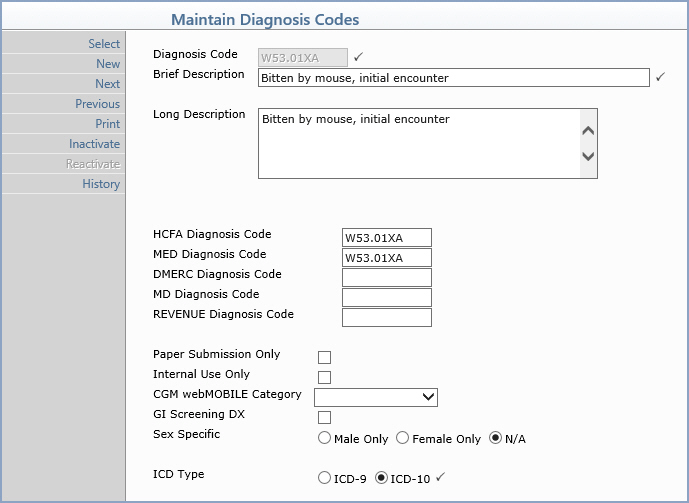| Prompt |
Response |
Req |
Len |
| Diagnosis Code |
Type the code you want or click the
magnifying glass to search the table. This code cannot begin with
a zero. |
|
10 |
| Brief Description |
Type a description of the diagnosis
code. |
 |
55 |
| Long Description |
This field is used primarily for descriptions
loaded with the AMA ICD-9 code file. You can type a detailed description
of the diagnosis code or leave the field blank. |
|
55*5 |
| HCFA Diagnosis Code |
Type the Equivalent code you want to
use on insurance claims for this insurance carrier. For more information
see the Equivalent Code help section under Introduction, System
Processes. |
|
10 |
| MEDICARE Diagnosis Code |
Type the Equivalent code you want to
use on insurance claims for this insurance carrier. For more information
see the Equivalent Code help section under Introduction, System
Processes. |
|
10 |
| BCBS Diagnosis Code |
Type the Equivalent code you want to
use on insurance claims for this insurance carrier. For more information
see the Equivalent Code help section under Introduction, System
Processes. |
|
10 |
| DMERC Diagnosis Code |
Type the Equivalent code you want to
use on insurance claims for this insurance carrier. For more information
see the Equivalent Code help section under Introduction, System
Processes. |
|
10 |
| Medicaid Diagnosis Code |
Type the Equivalent code you want to
use on insurance claims for this insurance carrier. For more information
see the Equivalent Code help section under Introduction, System
Processes. |
|
10 |
| Paper Submission Only |
If all procedures posted with this diagnosis
code should be forced to a 'paper claim', select this check box. |
|
1 |
| PQRS Diagnosis Check |
This field only applies to clients participating
in the Physician Quality Reporting System (PQRS) for Medicare.
If you want CGM webPRACTICE to provide a warning in procedure
entry whenever this diagnosis is entered and a corresponding 'F'
procedure code is not entered, select this check box. |
|
1 |
| GI Screening DX |
For Medicare colonoscopy diagnosis codes
only - This field has been added to adhere to Medicares colonoscopy
diagnosis requirements. If you perform a colonoscopy as a screening,
but a polyp is found and removed, Medicare requires the screening
(V) code to be submitted as the first diagnosis code and the polyp
code to be submitted as the secondary diagnosis, but the diagnosis
pointer needs to point to the secondary diagnosis. If you select
this check box for the polyp codes, the claims will be sent correctly. |
|
1 |


